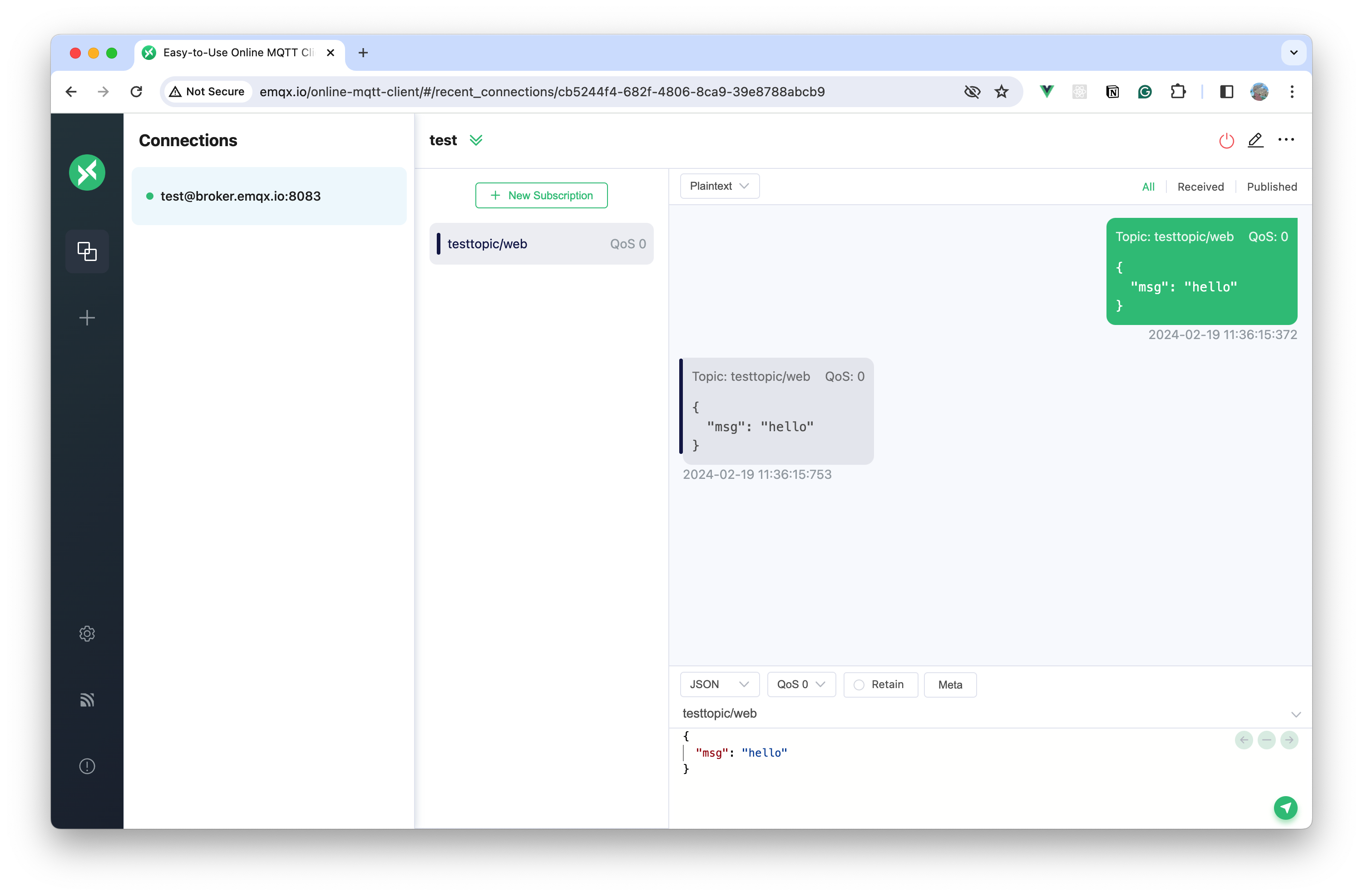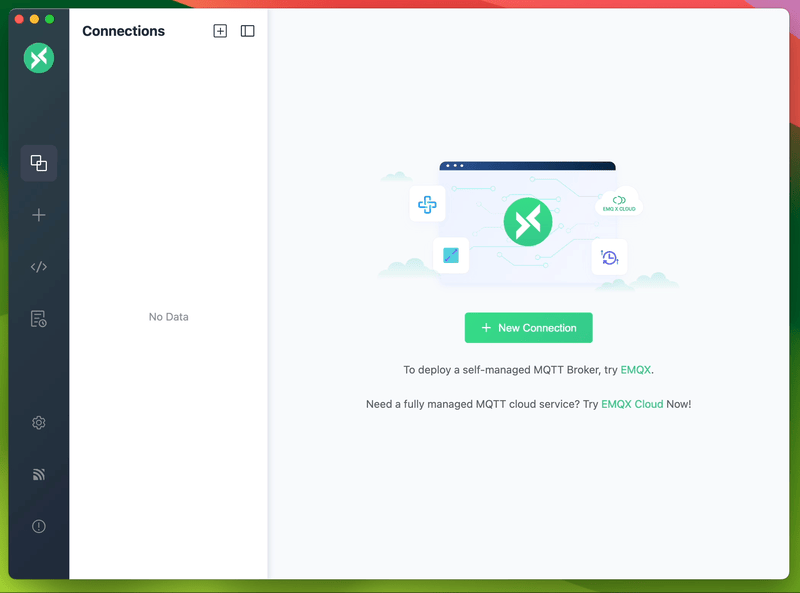104 lines
4.3 KiB
Markdown
104 lines
4.3 KiB
Markdown
|
|
[MQTTX](https://mqttx.app) is a cross-platform [MQTT 5.0](https://www.emqx.com/en/blog/introduction-to-mqtt-5) client tool open sourced by [EMQ](https://www.emqx.com/en), which can run on macOS, Linux and Windows, and supports formatting MQTT payload.
|
|||
|
|
|
|||
|
|
[MQTTX](https://mqttx.app) simplifies test operation with the help of a familiar, chat-like interface. It’s easy and quick to create multiple, simultaneous online MQTT client connections, and can test the connection, publishing, and subscription functions of MQTT/TCP, MQTT/TLS, MQTT/WebSocket as well as other MQTT protocol features.
|
|||
|
|
|
|||
|
|
> [MQTT](https://www.emqx.com/en/blog/the-easiest-guide-to-getting-started-with-mqtt) stands for MQ Telemetry Transport. It is a publish/subscribe, extremely simple and lightweight messaging protocol, designed for constrained devices and low-bandwidth, high-latency or unreliable networks.
|
|||
|
|
|
|||
|
|
## Preview
|
|||
|
|
|
|||
|
|

|
|||
|
|
|
|||
|
|
## Usage
|
|||
|
|
|
|||
|
|
See the MQTTX [documentation](https://mqttx.app/docs) or [manual](./docs/manual.md) for details.
|
|||
|
|
|
|||
|
|
1. Get MQTT Broker Ready.
|
|||
|
|
|
|||
|
|
- If you do not need to deploy the MQTT Broker locally, you can use the [public MQTT 5.0 Broker](https://www.emqx.com/en/mqtt/public-mqtt5-broker) provided by [EMQX Cloud](https://www.emqx.com/en/cloud) for testing:
|
|||
|
|
|
|||
|
|
```shell
|
|||
|
|
Broker IP: broker.emqx.io
|
|||
|
|
Broker TCP Port: 1883
|
|||
|
|
Broker SSL Port: 8883
|
|||
|
|
```
|
|||
|
|
|
|||
|
|
- To run MQTT Broker locally, use the [Eclipse Mosquitto](https://github.com/runtipi/runtipi-appstore/blob/master/apps/eclipse-mosquitto/) Tipi app. Follow the steps mentioned in its [description](https://github.com/runtipi/runtipi-appstore/blob/master/apps/eclipse-mosquitto/metadata/description.md) to turn on Websockets so that the MQTTX web client can connect to it.
|
|||
|
|
|
|||
|
|
2. Connection configuration. Click the `+` button in the left menu bar and fill in the corresponding required fields in the form.
|
|||
|
|
|
|||
|
|
3. After the connection information is configured, click the `Connect` button in the upper right corner to create a connection and connect to MQTT Broker.
|
|||
|
|
|
|||
|
|
4. After the MQTT is connected successfully, you can perform MQTT publish and subscription tests.
|
|||
|
|
|
|||
|
|

|
|||
|
|
|
|||
|
|
## Get Involved
|
|||
|
|
|
|||
|
|
- Follow [@EMQTech on Twitter](https://twitter.com/EMQTech).
|
|||
|
|
- If you have a specific question, check out our [discussion forums](https://github.com/emqx/emqx/discussions).
|
|||
|
|
- For general discussions, join us on the [official Discord](https://discord.gg/xYGf3fQnES) team.
|
|||
|
|
- Keep updated on [EMQX YouTube](https://www.youtube.com/channel/UC5FjR77ErAxvZENEWzQaO5Q) by subscribing.
|
|||
|
|
|
|||
|
|
## Develop
|
|||
|
|
|
|||
|
|
Recommended version for Node environment:
|
|||
|
|
|
|||
|
|
- v16.\*.\*
|
|||
|
|
|
|||
|
|
```shell
|
|||
|
|
# Clone
|
|||
|
|
git clone git@github.com:emqx/MQTTX.git
|
|||
|
|
|
|||
|
|
# Install dependencies
|
|||
|
|
cd MQTTX
|
|||
|
|
yarn install
|
|||
|
|
|
|||
|
|
# Compiles and hot-reloads for development
|
|||
|
|
yarn run electron:serve
|
|||
|
|
|
|||
|
|
# Compiles and minifies for production
|
|||
|
|
yarn run electron:build
|
|||
|
|
```
|
|||
|
|
|
|||
|
|
After the building is successful, the corresponding installation file for the successful build ing will appear in the `dist_electron` directory.
|
|||
|
|
|
|||
|
|
If you need to package it as an installation package for an independent operating system, please refer to the following command:
|
|||
|
|
|
|||
|
|
```shell
|
|||
|
|
# For Windows
|
|||
|
|
yarn run electron:build-win
|
|||
|
|
|
|||
|
|
# For Linux
|
|||
|
|
yarn run electron:build-linux
|
|||
|
|
|
|||
|
|
# For macOS
|
|||
|
|
yarn run electron:build-mac
|
|||
|
|
```
|
|||
|
|
|
|||
|
|
## Contributing
|
|||
|
|
|
|||
|
|
Please make sure to read the [Contributing Guide](https://github.com/emqx/MQTTX/blob/main/.github/CONTRIBUTING.md) before making a pull request.
|
|||
|
|
|
|||
|
|
## Technology Stack
|
|||
|
|
|
|||
|
|
- [Electron](https://electronjs.org/)
|
|||
|
|
- [Vue](https://vuejs.org/) + [Element](https://element.eleme.io)
|
|||
|
|
- [TypeScript](https://www.typescriptlang.org/)
|
|||
|
|
- [TypeORM](https://github.com/typeorm/typeorm)
|
|||
|
|
- [SQLite](https://github.com/mapbox/node-sqlite3)
|
|||
|
|
- [MQTT.js](https://github.com/mqttjs/MQTT.js)
|
|||
|
|
|
|||
|
|
## Resources
|
|||
|
|
|
|||
|
|
- [MQTT Programming](https://www.emqx.com/en/blog/category/mqtt-programming)
|
|||
|
|
|
|||
|
|
A series of blogs to help developers get started quickly with MQTT in PHP, Node.js, Python, Golang, and other programming languages.
|
|||
|
|
|
|||
|
|
- [MQTT SDKs](https://www.emqx.com/en/mqtt-client-sdk)
|
|||
|
|
|
|||
|
|
We have selected popular MQTT client SDKs in various programming languages and provided code examples to help you quickly understand the use of MQTT clients.
|
|||
|
|
|
|||
|
|
## License
|
|||
|
|
|
|||
|
|
Apache License 2.0, see [LICENSE](https://github.com/emqx/MQTTX/blob/main/LICENSE).
|